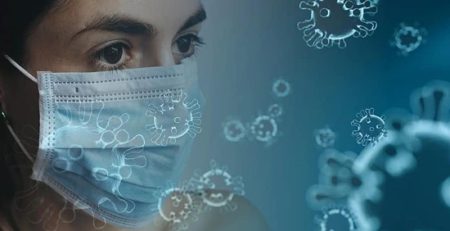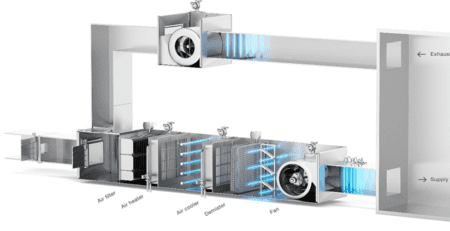‘Hygiene Theatre’: How excessive cleaning distracts us from the main airborne viral hazard
With the Centers for Disease Control and Prevention (CDC) publicising that there is only a less than 0.0001% chance of catching COVID-19 from a single infected surface1, excessive cleaning may not only not offer us the protection that we believe, but it may be luring us into a false sense of security.
The term ‘hygiene theatre’ was first used in July 2020 by Derek Thompson, a writer for The Atlantic, when he defined it as COVID-19 safety measures “that make us feel safer, but don’t actually do much to reduce risk, even as more dangerous activities are still allowed”.2
It is now widely accepted that COVID-19 is an airborne disease that can be transmitted via aerosols that can stay in the air for a few hours, and can travel several meters, especially inside due to air currents. This means that ensuring adequate ventilation in indoor settings is paramount.
However, ventilation is often forgotten in the shadow of excessive cleaning measures. With many well-intentioned businesses following strict hygiene protocols such as using disposable menus, constant cleaning of touchpoints and the use of shields between tables, it is easy to feel safe, however the threat from airborne transmission is still high.
Our current obsession with hygiene theatre is probably the result of incorrect risk analysis. This is likely to the effect of early public health messaging, which was based on early opinions of the transmission route of COVID-19, rather than the empirical evidence that was later published. However, public health messaging did not keep up with the latest research, with the World Health Organisation (WHO) only acknowledging the risk of airborne transmission in July 2020. Even now, the WHO still overemphasise the role of surface transmission of COVID-193.
This messaging can affect the safety of individuals across the world, as they are not aware of how best to mitigate the risk of COVID-19 transmission. As many people are focused on partaking in hygiene theatre, they may not feel that other mitigating measures, that are far more effective, such as increasing levels of ventilation and using air cleaning devices, are necessary.
Without hygiene theatre, it would be far clearer how reassurances about air exchanges in premises are much more important than looking at the number of hand sanitisers available.
In the UK, The Health and Safety Executive (HSE) make it clear that ventilation is critical to reduce the risk of coronavirus infection4. If “adequate ventilation” cannot be achieved through mechanical and/or natural ventilation, then the HSE states that local air cleaning and filtration units, such as high-efficiency filters or ultraviolet-based devices, can be used to reduce airborne transmission of aerosols5.
But what is adequate ventilation? It’s not recirculated air which unfortunately, is commonly used by the majority of mechanical HVAC systems installed pre-covid. Markers from regulators and institutions worldwide are now pointing towards 6 Air Changes per Hour (6ACH) of filtered outside air for pandemic resilience for indoor settings, depending on occupational use and risk.(At 6ACH, 95% of contaminants in the air are removed every 34 minutes.) Suppose you cannot provide “adequate ventilation” within your work-space using mechanical and natural ventilation alone?
Paul Waldeck, PP-L Biosafety’s Technical Director, added “We at PPL Biosafety are Chartered Engineers, Scientists and Medical Professionals. Whilst we are unusual because of that combination of expertise, it enables us to provide a turnkey approach to protecting our Clients. From risk assessment, gap-analysis, design, specification to the physical supply of high performance air cleaning solutions , we can mitigate or control the risk of not just coronavirus but also, other harmful microbes. We must also not be short-term and think about the future e.g. Influenza A is now of concern, as are Covid-19 variants, particularly those emerging with potential vaccine escape capabilities.
We have an armoury of world class interventions which are variant and indeed, pathogen agnostic which can be applied across the sectors. Importantly, beyond ventilation solutions, we correctly engineer, select, blend and supply GUV (Germicidal Ultraviolet Light) and/or High-Efficiency Filter solutions appropriate to an organisation’s environmental, operational risks and needs. The solutions always provide at least the equivalent of 6ACH of air decontamination to better protect people and operations beyond Covid, for the long term and exceed the necessary standards of compliance. “
Paul added, “Don’t stop cleaning surfaces, it’s still important but we need to think of the 80:20 rule in terms of priority when protecting against airborne pathogens such as coronavirus. 80% of your efforts in achieving adequate ventilation with clean uncontaminated air; and 20% of your efforts on cleaning surfaces. You’ll be future-ready
References
1 http://www.cdc.gov/coronavirus/2019-ncov/more/science-and-research/surface-transmission.html
2 http://www.theatlantic.com/ideas/archive/2020/07/scourge-hygiene-theater/614599/
4 http://www.hse.gov.uk/coronavirus/equipment-and-machinery/air-conditioning-and-ventilation/index.htm
5 http://www.hse.gov.uk/coronavirus/equipment-and-machinery/air-conditioning-and-ventilation/air-cleaning-and-filtration-units.htm






Leave a Reply